Download Fortinet NSE 7 -LAN Edge 7-0.NSE7_LED-7.0.VCEplus.2023-09-20.21q.vcex
| Vendor: | Fortinet |
| Exam Code: | NSE7_LED-7.0 |
| Exam Name: | Fortinet NSE 7 -LAN Edge 7-0 |
| Date: | Sep 20, 2023 |
| File Size: | 3 MB |
| Downloads: | 4 |
How to open VCEX files?
Files with VCEX extension can be opened by ProfExam Simulator.
Discount: 20%
Demo Questions
Question 1
Which two pieces of information can the diagnose test authserver ldap command provide? (Choose two.)
- It displays whether the admin bind user credentials are correct
- It displays whether the user credentials are correct
- It displays the LDAP codes returned by the LDAP server
- It displays the LDAP groups found for the user
Correct answer: BC
Explanation:
According to the FortiGate CLI Reference Guide, ''The diagnose test authserver ldap command tests LDAP authentication with a specific LDAP server. The command displays whether the user credentials are correct and whether the user belongs to any groups that match a firewall policy. The command also displays the LDAP codes returned by the LDAP server.'' Therefore, options B and C are true because they describe the information that the diagnose test authserver ldap command can provide. Option A is false because the command does not display whether the admin bind user credentials are correct, but rather whether the user credentials are correct. Option D is false because the command does not display the LDAP groups found for the user, but rather whether the user belongs to any groups that match a firewall policy. According to the FortiGate CLI Reference Guide, ''The diagnose test authserver ldap command tests LDAP authentication with a specific LDAP server. The command displays whether the user credentials are correct and whether the user belongs to any groups that match a firewall policy. The command also displays the LDAP codes returned by the LDAP server.'' Therefore, options B and C are true because they describe the information that the diagnose test authserver ldap command can provide. Option A is false because the command does not display whether the admin bind user credentials are correct, but rather whether the user credentials are correct. Option D is false because the command does not display the LDAP groups found for the user, but rather whether the user belongs to any groups that match a firewall policy.
Question 2
You are setting up an SSID (VAP) to perform RADlUS-authenticated dynamic VLAN allocation
Which three RADIUS attributes must be supplied by the RADIUS server to enable successful VLAN allocation'' (Choose three.)
- Tunnel-Private-Group-ID
- Tunnel-Pvt-Group-ID
- Tunnel-Preference
- Tunnel-Type
- Tunnel-Medium-Type
Correct answer: ADE
Explanation:
According to the FortiAP Configuration Guide, 'To perform RADIUS-authenticated dynamic VLAN allocation, the RADIUS server must supply the following RADIUS attributes: Tunnel-Private-Group-ID, which specifies the VLAN ID to assign to the user. Tunnel-Type, which specifies the tunneling protocol used for the VLAN. The value must be 13 (VLAN). Tunnel-Medium-Type, which specifies the transport medium used for the VLAN. The value must be 6 (802). Therefore, options A, D, and E are true because they describe the RADIUS attributes that must be supplied by the RADIUS server to enable successful VLAN allocation. Option B is false because Tunnel-Pvt-Group-ID is not a valid RADIUS attribute name, but rather a typo for Tunnel-Private-Group-ID. Option C is false because Tunnel-Preference is not a required RADIUS attribute for dynamic VLAN allocation, but rather an optional attribute that specifies the priority of the VLAN. According to the FortiAP Configuration Guide, 'To perform RADIUS-authenticated dynamic VLAN allocation, the RADIUS server must supply the following RADIUS attributes: Tunnel-Private-Group-ID, which specifies the VLAN ID to assign to the user. Tunnel-Type, which specifies the tunneling protocol used for the VLAN. The value must be 13 (VLAN). Tunnel-Medium-Type, which specifies the transport medium used for the VLAN.
The value must be 6 (802). Therefore, options A, D, and E are true because they describe the RADIUS attributes that must be supplied by the RADIUS server to enable successful VLAN allocation. Option B is false because Tunnel-Pvt-Group-ID is not a valid RADIUS attribute name, but rather a typo for Tunnel-Private-Group-ID. Option C is false because Tunnel-Preference is not a required RADIUS attribute for dynamic VLAN allocation, but rather an optional attribute that specifies the priority of the VLAN.
Question 3
Refer to the exhibit.
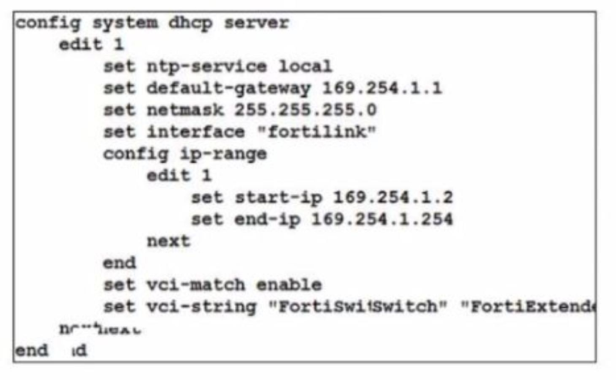
By default FortiOS creates the following DHCP server scope for the FortiLink interface as shown in the exhibit
What is the objective of the vci-string setting?
- To ignore DHCP requests coming from FortiSwitch and FortiExtender devices
- To reserve IP addresses for FortiSwitch and FortiExtender devices
- To restrict the IP address assignment to FortiSwitch and FortiExtender devices
- To restrict the IP address assignment to devices that have FortiSwitch or FortiExtender as their hostname
Correct answer: C
Explanation:
According to the exhibit, the DHCP server scope for the FortiLink interface has a vci-string setting with the value ''Cisco AP c2700''. This setting is used to match the vendor class identifier (VCI) of the DHCP clients that request an IP address from the DHCP server. The VCI is a text string that uniquely identifies a type of vendor device. Therefore, option C is true because the vci-string setting restricts the IP address assignment to FortiSwitch and FortiExtender devices, which use the VCI ''Cisco AP c2700''. Option A is false because the vci-string setting does not ignore DHCP requests coming from FortiSwitch and FortiExtender devices, but rather accepts them. Option B is false because the vci-string setting does not reserve IP addresses for FortiSwitch and FortiExtender devices, but rather assigns them dynamically. Option D is false because the vci-string setting does not restrict the IP address assignment to devices that have FortiSwitch or FortiExtender as their hostname, but rather to devices that have ''Cisco AP c2700'' as their VCI. According to the exhibit, the DHCP server scope for the FortiLink interface has a vci-string setting with the value ''Cisco AP c2700''. This setting is used to match the vendor class identifier (VCI) of the DHCP clients that request an IP address from the DHCP server. The VCI is a text string that uniquely identifies a type of vendor device. Therefore, option C is true because the vci-string setting restricts the IP address assignment to FortiSwitch and FortiExtender devices, which use the VCI ''Cisco AP c2700''. Option A is false because the vci-string setting does not ignore DHCP requests coming from FortiSwitch and FortiExtender devices, but rather accepts them. Option B is false because the vci-string setting does not reserve IP addresses for FortiSwitch and FortiExtender devices, but rather assigns them dynamically. Option D is false because the vci-string setting does not restrict the IP address assignment to devices that have FortiSwitch or FortiExtender as their hostname, but rather to devices that have ''Cisco AP c2700'' as their VCI.
Question 4
Refer to the exhibit.
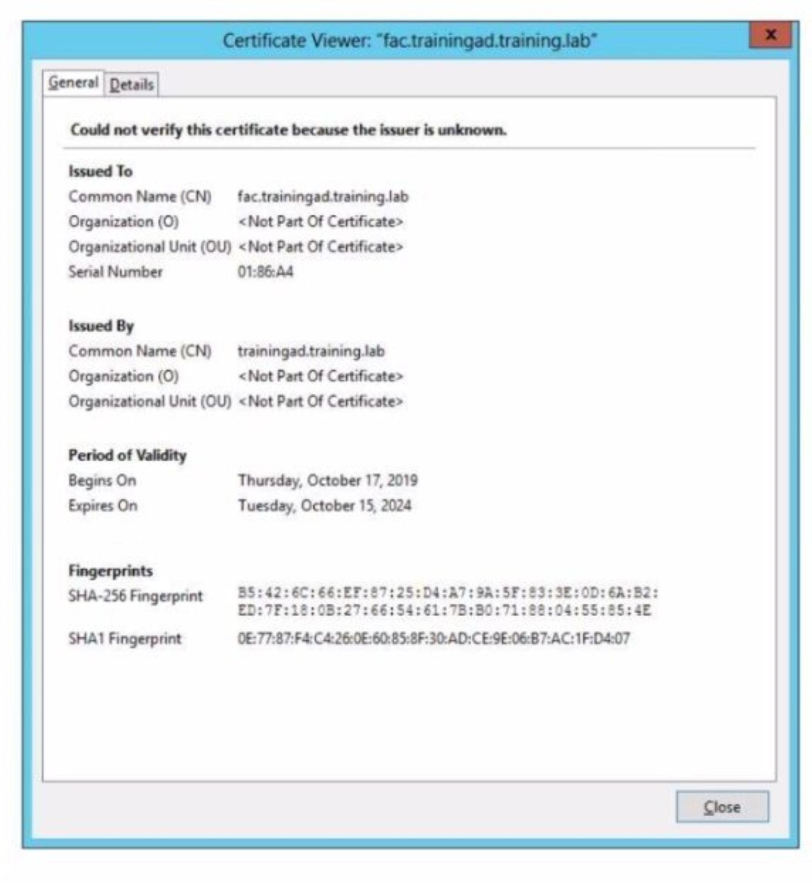
Wireless guest users are unable to authenticate because they are getting a certificate error while loading the captive portal login page. This URL string is the HTTPS POST URL guest wireless users see when attempting to access the
network using the web browser

Which two settings are the likely causes of the issue? (Choose two.)
- The external server FQDN is incorrect
- The wireless user's browser is missing a CA certificate
- The FortiGate authentication interface address is using HTTPS
- The user address is not in DDNS form
Correct answer: AB
Explanation:
According to the exhibit, the wireless guest users are getting a certificate error while loading the captive portal login page. This means that the browser cannot verify the identity of the server that is hosting the login page. Therefore, option A is true because the external server FQDN is incorrect, which means that it does not match the common name or subject alternative name of the server certificate. Option B is also true because the wireless user's browser is missing a CA certificate, which means that it does not have the root or intermediate certificate that issued the server certificate. Option C is false because the FortiGate authentication interface address is using HTTPS, which is a secure protocol that encrypts the communication between the browser and the server. Option D is false because the user address is not in DDNS form, which is not related to the certificate error. According to the exhibit, the wireless guest users are getting a certificate error while loading the captive portal login page. This means that the browser cannot verify the identity of the server that is hosting the login page. Therefore, option A is true because the external server FQDN is incorrect, which means that it does not match the common name or subject alternative name of the server certificate. Option B is also true because the wireless user's browser is missing a CA certificate, which means that it does not have the root or intermediate certificate that issued the server certificate. Option C is false because the FortiGate authentication interface address is using HTTPS, which is a secure protocol that encrypts the communication between the browser and the server. Option D is false because the user address is not in DDNS form, which is not related to the certificate error.
Question 5
When you configure a FortiAP wireless interface for auto TX power control which statement describes how it configures its transmission power'?
- Every 30 seconds the AP will measure the signal strength of the AP using the client The AP will adjust its signal strength up or down until the AP signal is detected at -70 dBm
- Every 30 seconds FortiGate measures the signal strength of adjacent AP interfaces It will adjust its own AP power to match the adjacent AP signal strength
- Every 30 seconds FortiGate measures the signal strength of adjacent FortiAP interfaces It will adjust the adjacent AP power to be detectable at -70 dBm
- Every 30 seconds FortiGate measures the signal strength of the weakest associated client The AP will then configure its radio power to match the detected signal strength of the client
Correct answer: A
Explanation:
According to the FortiAP Configuration Guide1, ''Auto TX power control allows the AP to adjust its transmit power based on the signal strength of the client. The AP will measure the signal strength of the client every 30 seconds and adjust its transmit power up or down until the client signal is detected at -70 dBm.'' Therefore, option A is true because it describes how the FortiAP wireless interface configures its transmission power when auto TX power control is enabled. Option B is false because FortiGate does not measure the signal strength of adjacent AP interfaces, but rather the FortiAP does. Option C is false because FortiGate does not adjust the adjacent AP power, but rather the FortiAP adjusts its own power. Option D is false because FortiGate does not measure the signal strength of the weakest associated client, but rather the FortiAP does. According to the FortiAP Configuration Guide1, ''Auto TX power control allows the AP to adjust its transmit power based on the signal strength of the client. The AP will measure the signal strength of the client every 30 seconds and adjust its transmit power up or down until the client signal is detected at -70 dBm.'' Therefore, option A is true because it describes how the FortiAP wireless interface configures its transmission power when auto TX power control is enabled. Option B is false because FortiGate does not measure the signal strength of adjacent AP interfaces, but rather the FortiAP does. Option C is false because FortiGate does not adjust the adjacent AP power, but rather the FortiAP adjusts its own power. Option D is false because FortiGate does not measure the signal strength of the weakest associated client, but rather the FortiAP does.
Question 6
Refer to the exhibit
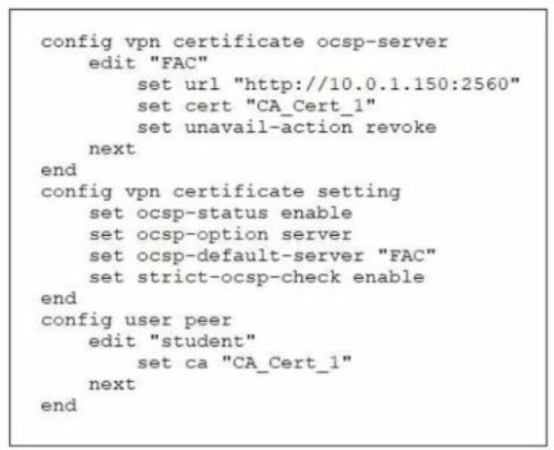
Examine the sections of the configuration shown in the output
What action will FortiGate take when verifying the student certificate through OCSP?
- Reject the student certificate if the OCSP server replies that the student certificate status is unknown
- Not verify the OCSP server certificate
- Use the OCSP URL included in the student certificate to verify the student certificate
- Consider the student certificate status as valid if the OCSP server is unreachable
Correct answer: C
Explanation:
According to the exhibit, the FortiGate configuration has ocsp-status enabled and ocsp-option set to certificate. This means that FortiGate will use OCSP to verify the revocation status of certificates presented by clients.According to the FortiGate Administration Guide2, ''If you select certificate, FortiGate uses an OCSP URL included in a certificate to verify that certificate.'' Therefore, option C is true because it describes what action FortiGate will take when verifying the student certificate through OCSP. Option A is false because FortiGate will not reject the student certificate if the OCSP server replies that the student certificate status is unknown, but rather accept it as valid. Option B is false because FortiGate will verify the OCSP server certificate by default, unless strict-ocsp-check is disabled. Option D is false because FortiGate will not consider the student certificate status as valid if the OCSP server is unreachable, but rather reject it as invalid. According to the exhibit, the FortiGate configuration has ocsp-status enabled and ocsp-option set to certificate. This means that FortiGate will use OCSP to verify the revocation status of certificates presented by clients.According to the FortiGate Administration Guide2, ''If you select certificate, FortiGate uses an OCSP URL included in a certificate to verify that certificate.'' Therefore, option C is true because it describes what action FortiGate will take when verifying the student certificate through OCSP. Option A is false because FortiGate will not reject the student certificate if the OCSP server replies that the student certificate status is unknown, but rather accept it as valid. Option B is false because FortiGate will verify the OCSP server certificate by default, unless strict-ocsp-check is disabled. Option D is false because FortiGate will not consider the student certificate status as valid if the OCSP server is unreachable, but rather reject it as invalid.
Question 7
Refer to the exhibit.
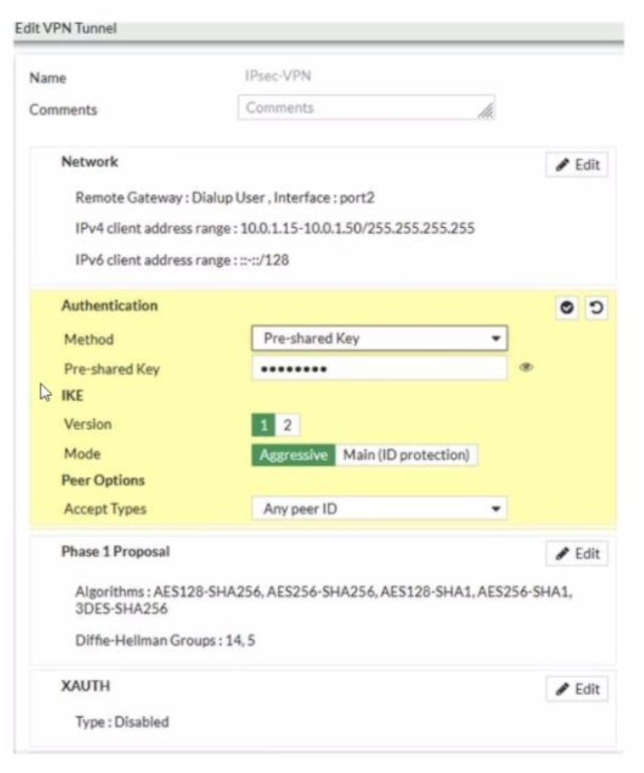
Examine the IPsec VPN phase 1 configuration shown in the exhibit
An administrator wants to use certificate-based authentication for an IPsec VPN user
Which three configuration changes must you make on FortiGate to perform certificate-based authentication for the IPsec VPN user? (Choose three)
- Create a PKI user for the IPsec VPN user, and then configure the IPsec VPN tunnel to accept the PKI user as peer certificate
- In the Authentication section of the IPsec VPN tunnel in the Method drop-down list select Signature and then select the certificate that FortiGate will use for IPsec VPN
- In the IKE section of the IPsec VPN tunnel in the Mode field select Main (ID protection)
- Import the CA that signed the user certificate
- Enable XAUTH on the IPsec VPN tunnel
Correct answer: BDE
Explanation:
According to the FortiGate Administration Guide, ''To use certificate-based authentication, you must configure the following settings on both peers: Select Signature as the authentication method and select a certificate to use for authentication. Import the CA certificate that issued the peer's certificate. Enable XAUTH on the phase 1 configuration.'' Therefore, options B, D, and E are true because they describe the configuration changes that must be made on FortiGate to perform certificate-based authentication for the IPsec VPN user. Option A is false because creating a PKI user for the IPsec VPN user is not required, as the user certificate can be verified by the CA certificate. Option C is false because changing the IKE mode to Main (ID protection) is not required, as the IKE mode can be either Main or Aggressive for certificate-based authentication. According to the FortiGate Administration Guide, ''To use certificate-based authentication, you must configure the following settings on both peers: Select Signature as the authentication method and select a certificate to use for authentication. Import the CA certificate that issued the peer's certificate. Enable XAUTH on the phase 1 configuration.'' Therefore, options B, D, and E are true because they describe the configuration changes that must be made on FortiGate to perform certificate-based authentication for the IPsec VPN user. Option A is false because creating a PKI user for the IPsec VPN user is not required, as the user certificate can be verified by the CA certificate. Option C is false because changing the IKE mode to Main (ID protection) is not required, as the IKE mode can be either Main or Aggressive for certificate-based authentication.
Question 8
You are configuring a FortiGate wireless network to support automated wireless client quarantine using IOC Which two configurations must you put in place for a wireless client to be quarantined successfully?
(Choose two)
- Configure the wireless network to be in tunnel mode
- Configure the FortiGate device in the Security Fabric with a FortiAnalyzer device
- Configure a firewall policy to allow communication
- Configure the wireless network to be in bridge mode
Correct answer: AB
Explanation:
According to the FortiGate Administration Guide, ''To enable automated wireless client quarantine using IOC, you must configure the following settings: Configure your wireless network to be in tunnel mode. This allows FortiGate to inspect all wireless traffic and apply security policies. Configure your FortiGate device in the Security Fabric with a FortiAnalyzer device. This allows FortiAnalyzer to detect indicators of compromise (IOC) from wireless traffic and send quarantine commands to FortiGate.'' Therefore, options A and B are true because they describe the configurations that must be put in place for a wireless client to be quarantined successfully using IOC. Option C is false because configuring a firewall policy to allow communication is not required, as the default firewall policy for tunnel mode wireless networks is to allow all traffic. Option D is false because configuring the wireless network to be in bridge mode is not supported, as FortiGate cannot inspect or quarantine wireless traffic in bridge mode. According to the FortiGate Administration Guide, ''To enable automated wireless client quarantine using IOC, you must configure the following settings: Configure your wireless network to be in tunnel mode. This allows FortiGate to inspect all wireless traffic and apply security policies. Configure your FortiGate device in the Security Fabric with a FortiAnalyzer device. This allows FortiAnalyzer to detect indicators of compromise (IOC) from wireless traffic and send quarantine commands to FortiGate.'' Therefore, options A and B are true because they describe the configurations that must be put in place for a wireless client to be quarantined successfully using IOC. Option C is false because configuring a firewall policy to allow communication is not required, as the default firewall policy for tunnel mode wireless networks is to allow all traffic. Option D is false because configuring the wireless network to be in bridge mode is not supported, as FortiGate cannot inspect or quarantine wireless traffic in bridge mode.
Question 9
Refer to the exhibits
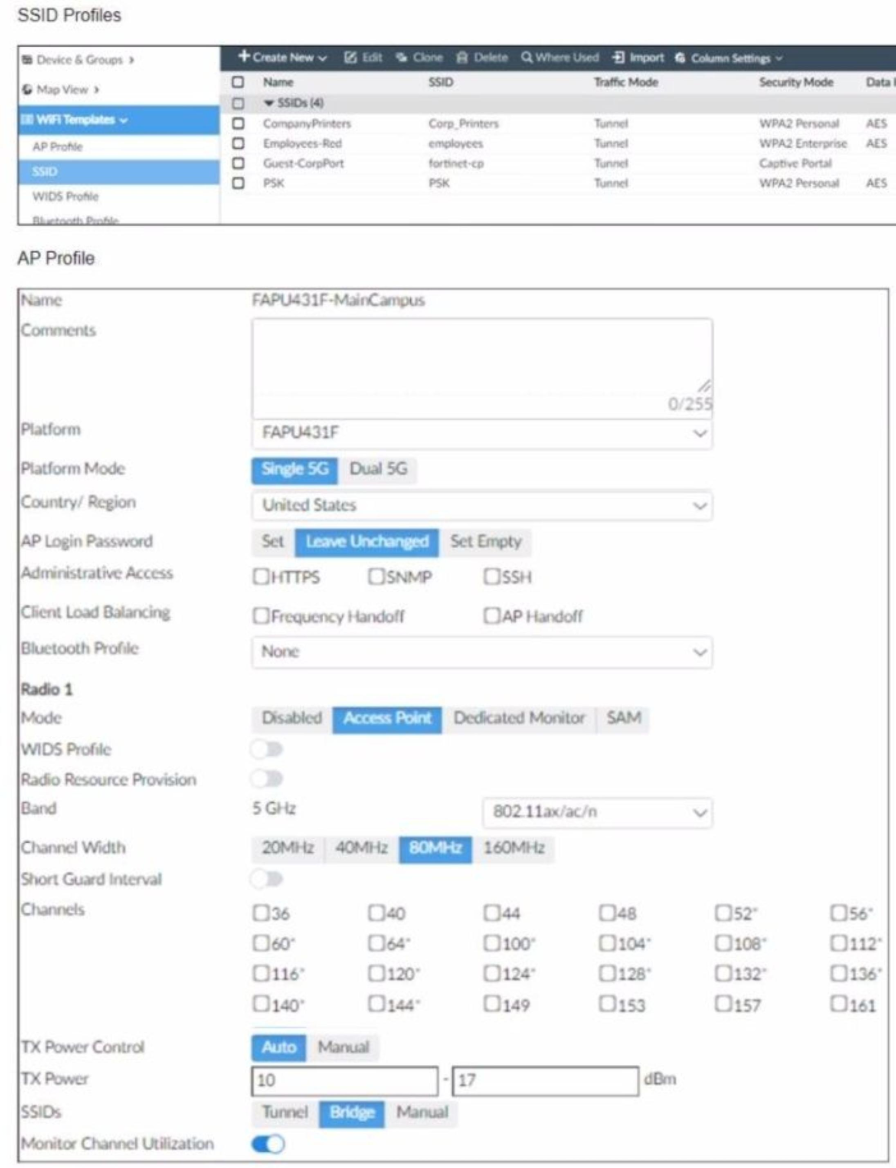
The exhibits show the wireless network (VAP) SSID profiles defined on FortiManager and an AP profile assigned to a group of APs that are supported by FortiGate None of the APs are broadcasting the SSlDs defined by the AP profile
Which changes do you need to make to enable the SSIDs to broadcast?
- In the SSIDs section enable Tunnel
- Enable one channel in the Channels section
- Enable multiple channels in the Channels section and enable Radio Resource Provision
- In the SSIDs section enable Manual and assign the networks manually
Correct answer: B
Explanation:
According to the FortiManager Administration Guide1, ''To enable the SSID, you must select at least one channel for the radio. If no channels are selected, the SSID will not be enabled.'' Therefore, enabling one channel in the Channels section will allow the SSIDs to broadcast. According to the FortiManager Administration Guide1, ''To enable the SSID, you must select at least one channel for the radio. If no channels are selected, the SSID will not be enabled.'' Therefore, enabling one channel in the Channels section will allow the SSIDs to broadcast.
Question 10
Which two statements about the guest portal on FortiAuthenticator are true? (Choose two.)
- Each remote user on FortiAuthenticator can sponsor up to 10 guest accounts
- Administrators must approve all guest accounts before they can be used
- The guest portal provides pre and post-log in services
- Administrators can use one or more incoming parameters to configure a mapping rule for the guest portal
Correct answer: CD
Explanation:
According to the FortiAuthenticator Administration Guide2, ''The guest portal provides pre and post-log in services for users (such as password reset and token registration abilities), and rules and replacement messages can be configured.'' Therefore, option C is true. The same guide also states that ''Administrators can use one or more incoming parameters to configure a mapping rule for the guest portal.'' Therefore, option D is true. Option A is false because remote users can sponsor any number of guest accounts, as long as they do not exceed the maximum number of guest accounts allowed by the license. Option B is false because administrators can choose to approve or reject guest accounts, or enable auto-approval. According to the FortiAuthenticator Administration Guide2, ''The guest portal provides pre and post-log in services for users (such as password reset and token registration abilities), and rules and replacement messages can be configured.'' Therefore, option C is true. The same guide also states that ''Administrators can use one or more incoming parameters to configure a mapping rule for the guest portal.'' Therefore, option D is true. Option A is false because remote users can sponsor any number of guest accounts, as long as they do not exceed the maximum number of guest accounts allowed by the license. Option B is false because administrators can choose to approve or reject guest accounts, or enable auto-approval.
HOW TO OPEN VCE FILES
Use VCE Exam Simulator to open VCE files

HOW TO OPEN VCEX AND EXAM FILES
Use ProfExam Simulator to open VCEX and EXAM files


ProfExam at a 20% markdown
You have the opportunity to purchase ProfExam at a 20% reduced price
Get Now!



